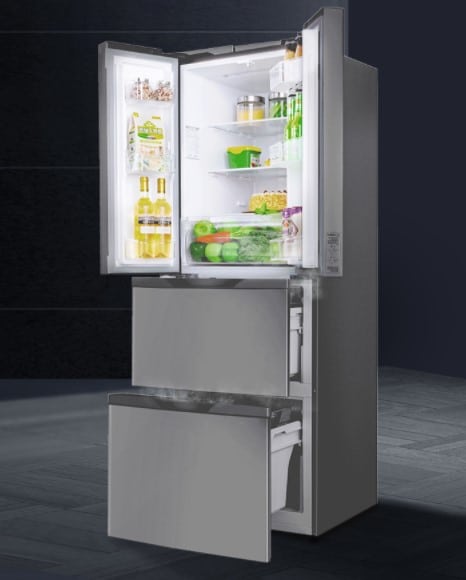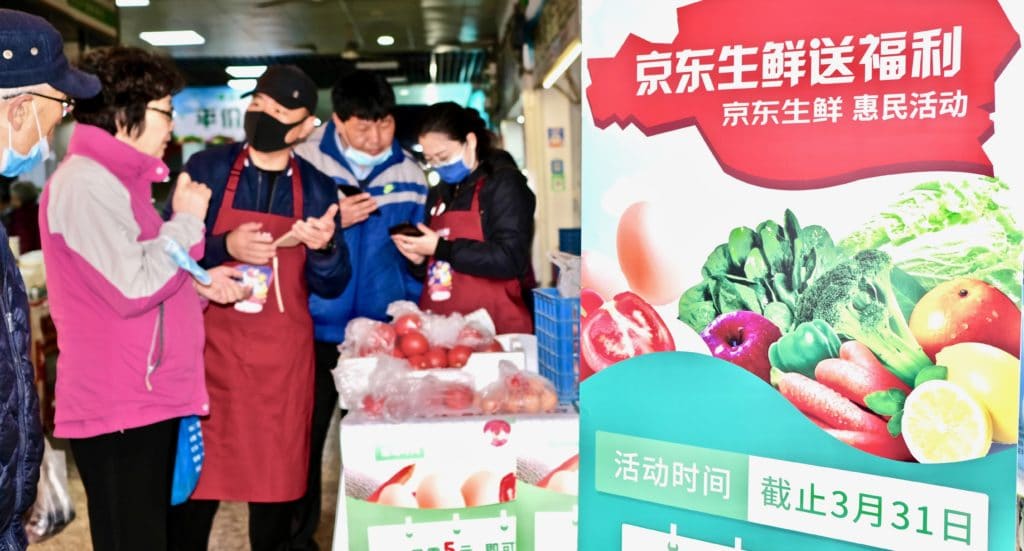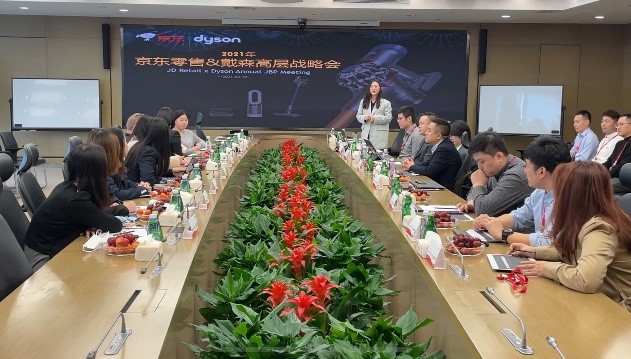by Ling Cao
As a technology and service enterprise with supply chain at its core, JD is combining technology innovation with the real economy. This is what Dr. Jinfeng Yi, head of Machine Learning at JD Technology and his team strive to achieve. Yi, a 33-year-old from Chengdu, Sichuan province, was named one of MIT Technology Review’s “Innovators under 35 in China” for 2020. He was also the only individual recipient of JD’s “CEO Special Award” in 2020 selected from over 360,000 employees.
 Jinfeng Yi at Bear Mountain in State of New York, USA
Jinfeng Yi at Bear Mountain in State of New York, USA
Smart supply chain and a fully automated C2M system
At JD, Yi is committed to constructing a more intelligent, collaborative, and effective supply chain, and has led several significant innovations along the way.
One of them is the C2M (Consumer-to-Manufacturer), also known as the C2B (Consumer-to-Business) model. The C2M model enables customers’ preferences and demands to be a determining factor for what companies should produce and sell, thus evolving supply chains from a traditional enterprise-driven process into a more effective customer-driven process.
C2M isn’t new, but a critical problem remains unsolved, which is how enterprises can effectively pick truly valuable information from a massive amount of customers. Besides, these customers usually lack the channels and the motivation to tell enterprises what they think, making the problem even more challenging.
To address the problem, Yi led his team to build the first fully automated and smart C2M system in industry, which takes advantage of AI technologies and anonymous data from more than 400 million of JD’s annual active customers. The proposed system is able to predict common and tailored customer needs and automatically design top-selling products in various market segments.
Yi shared, “Compared with traditional labor-intensive designs, this new system can make optimal choices for each product attribute to achieve the highest possible sales volume and satisfaction rate, and largely shorten R&D and production cycles.”
Note that a traditional C2M model based on human experience can also guide manufacturers on optimizing a small number of product attributes based on consumption trends. However, it is hard to do with products with a large number of attributes. One example is a big appliance such as a refrigerator, which has over 100 attributes, ranging from color, capacity, compressor, featured functions and many more. Since each attribute has multiple selections, a high number of attributes leads to a mass amount of potential combinations that would be difficult to objectively assess. To address this problem, the proposed system leverages advanced AI technologies to provide the optimal choice for each attribute, ultimately finding the most favored solution from customer data.
In addition, the system can help predict market performance such as sales and rates of positive and negative comments for the product, and monitor the whole lifecycle of an item, making the decision-making process much easier.
Yi added, “We can put the new product into the system, and predict its performance in the simulation environment, in order to decide whether and how to make adjustments.”
The system is also interactive, rather than just outputting a traditional recommendation report. In the system, brands can adjust the suggested choices in real-time to suit real-world constraints. For example, the system may suggest using an inverter compressor, but as this suggestion would require a huge investment to build new infrastructure on the existing production line, the brand can change it to fixed frequency compressor to reduce costs. In the cases when an adjustment has been made, the new prediction can be viewed through the system almost instantly.
After nearly one year of self-developing the system from scratch, it was put into trial operations ahead of JD’s 618 Grand promotion in 2020. Using the system, JD and the brand Gree developed a new refrigerator within just two months to be sold during the promotion. This was the first product to be created for a brand via the system.
Some of the suggested functions for the new product including adding dry and wet separation functions to store different fruits and vegetables, as well as an antibacterial deodorization function which uses ion technology, plus an automatic ice-making dispenser and frequency conversion for energy saving. The system helped Gree shorten the design and production cycle of large appliances by more than 80%, saving costs while guaranteeing the same level of quality and high customer satisfaction. During 618, the product was the best-seller in terms of sales volume of 71 new multi-door refrigerators on JD.
 GREE’s C2M refrigerator
GREE’s C2M refrigerator
In addition to Gree’s case, the system has already helped several other brands to produce new products, such as a new electric toothbrush for domestic brand Roaman. It helped the brand design four products that were all sold well on JD. New functions on the Roaman products include a high-performance magnetic levitation sonic motor, smart brush head replacement reminder and ultra-long battery life. “Going forward, we will open these capabilities to more partners, promoting business development via technology.” said Yi.
 Roaman’s electric toothbrush
Roaman’s electric toothbrush
Given its tremendous innovations and practical values, this system has gained the Innovation Award of Management Science, which is China’s only national-level award in management science.
Optimize the smart dialog system
Yi has obtained a PhD in AI at Michigan State University, under the supervision of Profs. Rong Jin and Anil. K. Jain. Prior to joining JD.com, Yi worked as a Research Staff Member at the IBM Thomas J. Watson Research Center, which serves as the headquarters of IBM Research – one of the largest industrial research organizations in the world. The systematic learning and the working experience in the industry’s pioneer facilities have made clear to Yi one thing: technology can be used to make the world better.
 Yi talks at a JD lunch event at the top AI conference IJCAI (International Joint Conferences on Artificial Intelligence) in Stockholm, Sweden in 2018
Yi talks at a JD lunch event at the top AI conference IJCAI (International Joint Conferences on Artificial Intelligence) in Stockholm, Sweden in 2018
Holding true to this long-term goal, Yi decided to come back to China and join JD, as he believes in JD’s reputation of authenticity, and was attracted to the company’s energetic atmosphere. Furthermore, his background in supply chain programs when he was at IBM was also a perfect match. Led by Yi, his team aims to conduct fundamental and applied research in machine learning and trustworthy AI, and build full-stack AI solutions supporting JD’s businesses in retail, finance, supply chain, and cloud computing.
To stay highly sensitive to the frontlines of the business, Yi often listens to customers’ feedback, and tries to improve products and services accordingly. He even talks with people like couriers, taxi drivers and barbers on what their pain points are at work, and thinks about what kind of smart services can help them address these issues.
Yi shared, “Another valuable thing we have done is to help optimize the smart dialog systems for customer service. ‘Customer first’ is one of JD’s core values, so the online dialog system is crucial to us.”
Yi’s team has worked on improving efficiency and accuracy of the system, introducing AI-driven query prediction and customer service allocation mechanisms. Based on the customer’s profile and historical shopping analysis, Yi’s team built a system that can automatically find out the reason for a customer query and the level of urgency, in order to help them connect with the right customer service, similar to a hospital guide. This system significantly increases the problem resolution and user satisfaction rates by 32.1% and 34.4% respectively, and reducing CES (Customer Effort Score) from 12.2% to 3.2%. Yi said, “In this case, technology can largely reduce the labor intensity of our customer service employees and increase user satisfaction, especially during peak periods.”
Trustworthy AI
Apart from his remarkable achievements in supply chains and other smart systems, Yi has also made key contributions to the concept of “Trustworthy AI,” especially in the field of adversarial machine learning.
Dr. Bowen Zhou, IEEE Fellow and the chairman of JD Technology Committee once commented, “In addition to Dr. Yi’s groundbreaking contributions to supply chains, he is also an extraordinary researcher who has made substantial progress in advancing the frontiers of AI. He has published over 50 papers in prestigious international conferences and journals such as NeurIPS, ICML, KDD, ACL, and ICCV. Notably, he is one of the pioneers in studying the adversarial machine learning problems. He proposed a series of classical algorithms, including ZOO, EAD, Seq2Sick, and AutoZOOM, and has significantly contributed to understanding the root causes behind the existence of adversarial examples and improving the AI model robustness.”
Prof. Anil K. Jain, who is a member of the U.S. National Academy of Engineering (NAE) and a member of The World Academy of Science (TWAS) also commented: “Over the past decade, Dr. Yi has been devoted to designing more secure and reliable AI models, and along the way, has created significant research and application value in many fields. Most algorithms proposed by Dr. Yi were backed by rigorous theoretical guarantees, ensuring that critical errors can be avoided even in the worst-case scenario.” This verifies that Yi attaches great importance to model reliability when conducting AI research.
Yi also believes that technology will be a force for good in society. “In my opinion, the future of the world is not about the competition between AI and humans; it is about who is good at using AI. AI can work as an assistant to help people solve many issues and improve their work efficiency.” During his work at JD, he has also contributed to making several anti-epidemic smart products in a short time via AI, and put them into the market application free of charge, including a widely-used daily necessity supply platform.
Yi is passionate when talking about technology. He sees his job as a life-long career; it is like climbing Qomolangma. He is always energetic, and always looks around to ensure he is taking the right path to the top.
“I’m still exploring more through AI and machine learning, especially on creating an effective, inclusive, and safe smart supply chain. JD’s fruitful real applications are fertile soil to maximize the value of technology, which will gradually make our contribution to digital transformation of the real economy,” said Yi.
(ling.cao@jd.com)




















